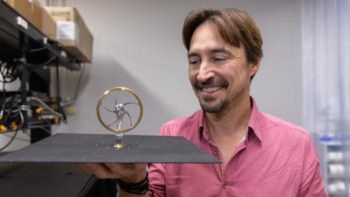
Researchers in France have developed a new open-source tool to help scientists understand and reduce the carbon footprint of their labs. From the 500 or so labs that have already used the tool – called GES 1point5 – the researchers have discovered that heating, travel and commuting are the main factors that contribute to a lab’s carbon footprint. The team also finds, however, that there is no one-size-fits-all strategy that allows research groups to reduce their emissions (to appear in Environmental Research: Infrastructure and Sustainability).
In recent years there has been increased focus on the energy required to run modern physics labs and facilities as well as what general research activities – such as travelling to conferences – contributes to climate change. This has led to discussions around balancing the impacts of research with the beneficial knowledge it produces, especially when it comes to climate change. Lately, however, there has been a shift towards the notion that researchers should lead by example to mitigate such impacts.
The new tool, which has been developed as part of Labos 1point5 – an international group of academics who aim to estimate, analyse and reduce the environmental impact of research – asks users to enter information about their lab. This includes data such as the buildings’ heating systems, the lab’s electricity usage, how members commute, and how often and how far researchers travel to professional events.
The tool then estimates the lab’s carbon footprint by multiplying the amount of each activity by a greenhouse gas emission factor for that activity as listed in a public database maintained by the French Environment and Energy Management Agency that estimates emissions associated with various activities.
Carbon cost
As well as enabling individual groups to assess their own impact, GES 1point5 collects that data into a national database that allows researchers to investigate the footprint of research more generally. So far, the researchers have concluded that there is no blanket mitigation policy that can be applied effectively to all labs, since each lab has a unique emissions profile with its own requirements for its research. However, heating, travel and commuting are seen as the major components of emissions due to research, while electricity consumption in the lab, digital devices such as computers, and the energy used to cool refrigerant gases are not. The huge carbon footprint of large-scale computing
The researchers are now using the data to investigate whether there is a correlation between air-travel emissions and academic success, as well as if there are inequalities in the distribution of the carbon footprint between different labs and how specific mitigation policies affect labs’ impacts. In future, they will further refine GES 1point5 to include more emissions sources, such as purchased goods and services, as well as allowing it to be used to calculate the carbon footprint of large facilities like particle accelerators.
The GES 1point5 team is also working to build a community of academics developing their own mitigation strategies. “We are currently in the process of creating a network of research labs mitigating their emissions,” Tamara Ben Ari from the University of Paris told Physics World. “This network will be a space to exchange ideas and solutions and should be available for any research lab to join in 2023.”



